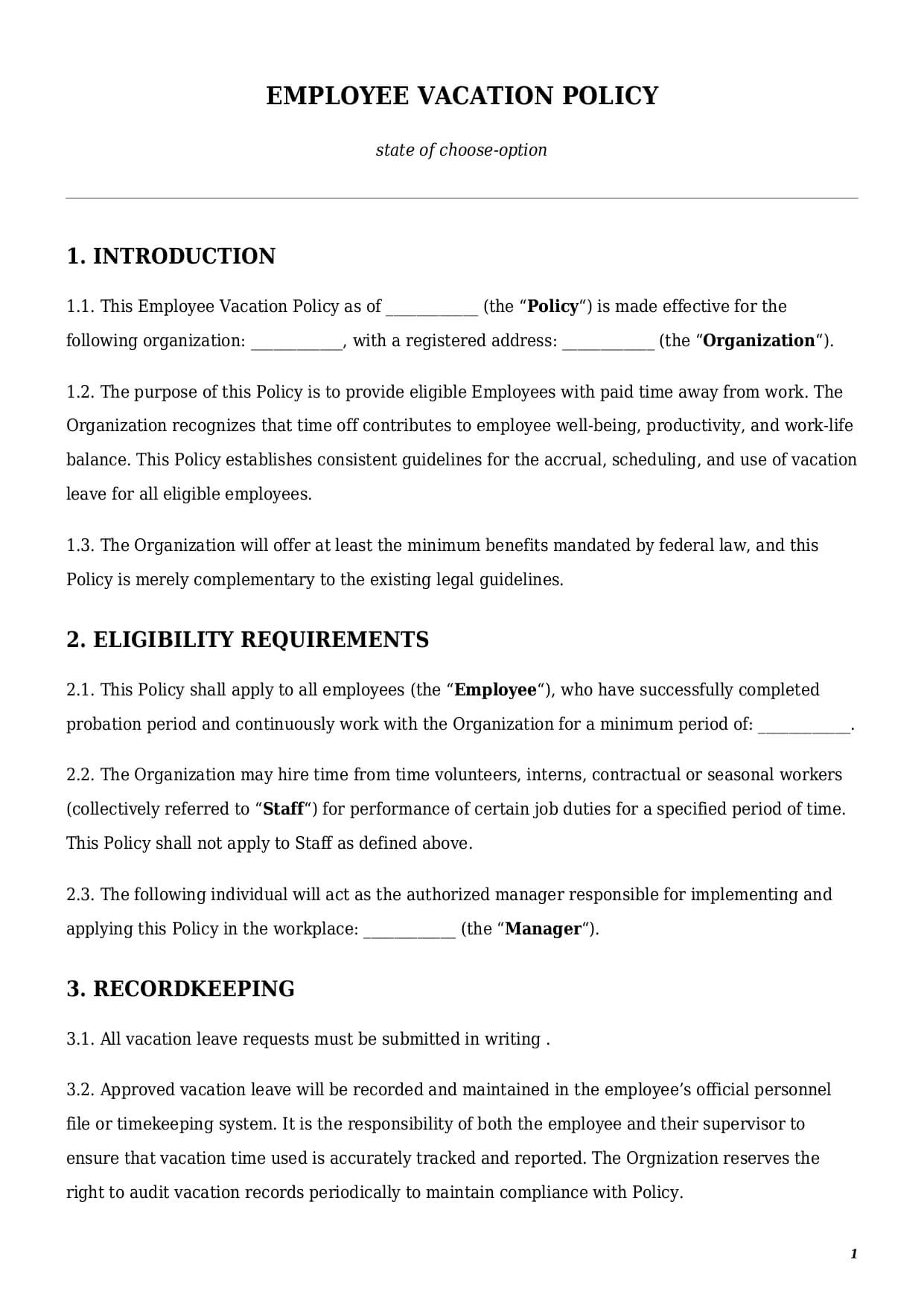Employee Vacation Policy
Reviews


What is the employee vacation policy?
An employee vacation policy is a formal legal document that establishes the rules, procedures, and standards for granting paid or unpaid vacation leave to employees. This policy defines a solid legal framework for the provision of vacation within the organization, including:
- types of available leaves (paid, non-paid, military, annual, jury, etc.);
- scope of application or eligibility;
- amendment process;
- procedures for requesting the leave;
- duration of leave, etc.
While adoption of an employee vacation policy is not directly required by a federal law, most businesses tend to have it. It ensures organizational planning, internal compliance, and clarity of HR processes within the organization.
A vacation policy template is a one-sided agreement between a business and its employees. “One-sided” means that the business adopts certain rules and conditions for requesting the leave, and employees shall comply with those rules.
This template does not cover provision of pregnancy disability leave, maternity or parental leave, thus another template shall be used instead.
How to draft an employee vacation policy template?
Drafting an effective employee vacation policy template helps to ensure internal compliance within the organization. Below we made the list of important pillars every policy template dealing with vacation and leave within the company should have.
Types of Leave
Even a simple vacation policy template shall provide the list of all types of leave available within the organization. As a requirement of federal and state laws, every organization or business shall provide their employees with mandatory paid annual leave. However, this is not the only type of leave an employee may request. Thus, the text of a policy may also include:
- duty jury leave (i.e., a mandatory leave an employee may take to serve their jury duty);
- bereavement leave (i.e., an optional leave in case of the death of an employee’s immediate family member);
- military leave (i.e., a mandatory leave when an employee takes the decision to serve in military forces); or
- military family leave (i.e., an optional leave for an employee who wishes to spend their time with their spouse or partner who is serving in military service).
The text of an employee vacation policy should clearly define the number of days an employee may get for each specific type of leave.
Leave Request Procedure
Taking an annual or other type of leave is a complex internal process that requires prior notification from an employee. Therefore, the text of a vacation policy template should provide the exact notice period an employee shall follow to get the leave.
A notice period may range from two weeks to 30 days, depending on the size of an organization. In bigger companies the notice period may even be several months to make sure a calendar of vacation for all employees is formed properly.
Another important consideration is the request submission process. Basically, this is how an employee shall submit their request for the leave. An employee may do so:
- in person by delivering a private letter to the HR department;
- by sending an email; or
- by submitting a request via the organization’s internal portal.
Last but not least is to define a person responsible for handling leave requests and overseeing the application of a vacation policy in general. Normally it could be a head of HR or any other person specifically appointed to deal with employees’ annual leave.
Amendment Process
An organization should be able to amend their vacation policy template at any time. If amendments or changes to the policy take place, an organization shall notify employees immediately. A solid employee vacation policy sample shall define how exactly such notification takes place:
- in person (by sending a private email to every employee);
- by announcing changes on the organization’s intranet; or
- by printing copies of the new policy and distributing them physically amongst employees.
Eligibility Requirements
A solid employee vacation policy template should define categories of employees or staff who are covered by this policy. The text of a document may include the following categories of employees eligible for taking the leave:
- full-time employees;
- part-time employees;
- interns or volunteers;
- contractors working for an organization by virtue of service agreements;
- seasonal workers;
- remote employees, etc.
Some companies may limit an employee’s right to request a leave to a period of time they have already worked in the company. In most of the cases, employees may not be eligible for any leave until the end of their probation period. At the same time, organizations may include a specific minimum period of time an employee shall work to be eligible for vacation.
Additional Tips
Along with giving the right to take a leave, organizations may provide their employees with a number of additional rights. Therefore, a good employee vacation policy example shall address the following:
- Rollover of unused days of vacation: It happens that an employee may have unused days of annual paid leave during the year. Thus, the policy shall define if an employee may roll over those days to the next calendar year.
- Unused days of vacation and termination of employment: The text of the policy shall define what will happen with unused days of paid annual leave in case of a contract’s termination.
- Advance usage of annual leave: An organization may also decide in a vacation policy template if employees can take their annual paid leave before it is actually accrued.
How to customize a policy template at Faster Draft?
To get a fully customized policy template, follow a few easy steps below:
- Click the button “Create Document.”
- Answer simple questions in the form.
- Select a document’s format—vacation policy template PDF or Word.
- Make a payment.
- Download, print, and distribute this policy amongst employees of your organization.
Table of content
Frequently Asked Questions (FAQ)
-
1. Who can use a time-off vacation policy template?
This policy could be used by both for-profit and non-profit organizations and businesses across the U.S.
No matter how big your business or organization and the number of employees it has, having a solid vacation policy template is a must. It provides a clear set of rules and guidelines regarding applying for, using, and postponing an employee’s leave.
-
2. What shall I do with my unused annual vacation leave if my employment contract is terminated?
It is a very common situation when an employment contract is terminated, but an employee still has a number of unused days of paid time off. There are several possible outcomes for a situation like that:
- First, an employee may use all paid days of vacation prior to the last working day;
- Second, an employee may request cash compensation for unused days of paid annual leave that will be included in a final paycheck; or
- Third, an employee may use part days of vacation and for the remaining part request a monetary compensation.

Looking for something Different?
Start typing to find out our collection of legal documents and contract templates
